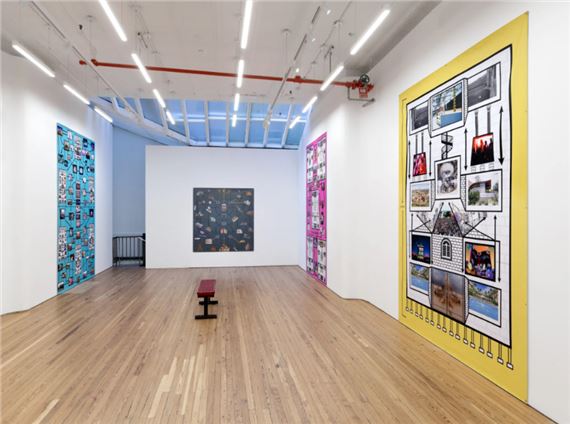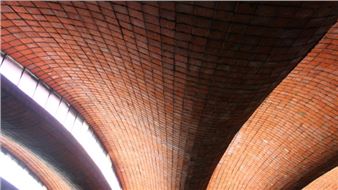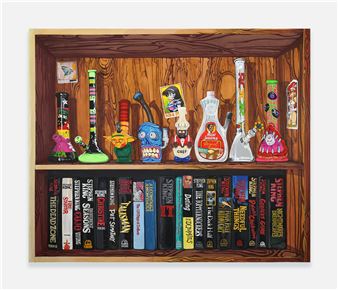Nick Angelo: Edifice
Many ravers have a similar memory, a zeitgeist recollection of low-end pulsations traveling through space, concrete, and rock. Disorientating color lights, phase-shifting frequencies, and hallucinogens in the bloodstream are all familiar echoes. Yet, those memories are often accompanied by a persistent sense of aesthetic and even social fatigue. A gnawing sense that the scene was better before.
Entering the gallery and exhibition Edifice by Los Angeles-based artist Nick Angelo, one confronts a series of large images whose materiality touches the viewer at the subliminal smell of plastic vinyl. The smell fades over time, as it does with machine-produced printing whether on paper, canvas, or PVC sheeting – complementary to the transient musk of polyvinyl chloride (“vinyl”) records.
In Edifice, Angelo maps the relationships between libidinal cultural and subcultural formations and their feverish capture by finance capital and real estate. Inspired by watching from a distance the evolution of Southern California’s Coachella Festival in the late 1990s to the present, Angelo diagrams a history and its chaos, a history of hippies, rave culture, festivals, and art institutions. Three of the pieces in Edifice deploy a tension between images depicting a linear history of institutions and architectures. The images of that history are then encircled in an “image cloud” mined from spectacle culture. A fourth banner features only a diagrammed linear narrative. Inversely, a fifth banner contains only an “image cloud” absent any central historical schema.

Many ravers have a similar memory, a zeitgeist recollection of low-end pulsations traveling through space, concrete, and rock. Disorientating color lights, phase-shifting frequencies, and hallucinogens in the bloodstream are all familiar echoes. Yet, those memories are often accompanied by a persistent sense of aesthetic and even social fatigue. A gnawing sense that the scene was better before.
Entering the gallery and exhibition Edifice by Los Angeles-based artist Nick Angelo, one confronts a series of large images whose materiality touches the viewer at the subliminal smell of plastic vinyl. The smell fades over time, as it does with machine-produced printing whether on paper, canvas, or PVC sheeting – complementary to the transient musk of polyvinyl chloride (“vinyl”) records.
In Edifice, Angelo maps the relationships between libidinal cultural and subcultural formations and their feverish capture by finance capital and real estate. Inspired by watching from a distance the evolution of Southern California’s Coachella Festival in the late 1990s to the present, Angelo diagrams a history and its chaos, a history of hippies, rave culture, festivals, and art institutions. Three of the pieces in Edifice deploy a tension between images depicting a linear history of institutions and architectures. The images of that history are then encircled in an “image cloud” mined from spectacle culture. A fourth banner features only a diagrammed linear narrative. Inversely, a fifth banner contains only an “image cloud” absent any central historical schema.
Artists on show
Related articles
Many ravers have a similar memory, a zeitgeist recollection of low-end pulsations traveling through space, concrete, and rock.
Many ravers have a similar memory, a zeitgeist recollection of low-end pulsations traveling through space, concrete, and rock. Disorientating color lights, phase-shifting frequencies, and hallucinogens in the bloodstream are all familiar echoes.

 ARTISTS
ARTISTS











